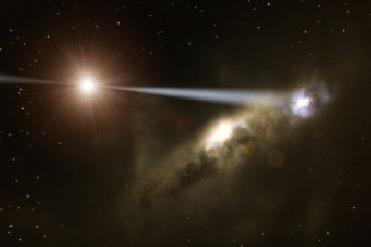
This artist�s impression shows how jets from supermassive black holes could form galaxies, thereby explaining why the mass of black holes is larger in galaxies that contain more stars. Image credit: ESO
PARIS (BNS): Astronomers seeking an answer to �what came first� question while studying black holes and their hosting galaxies have come across a new theory � black holes may be �building� their own host galaxy.
Conducting an extensive study of a nearby quasar HE0450-2958 located some 5 billion light-years away, a team of researchers has found that the �homeless� object is spewing a jet of highly energetic particles towards its neighbouring galaxy.
Until now, it was speculated that the quasar�s host galaxy was hidden behind large amounts of dust.
�However, we did not find any. Instead we discovered that an apparently unrelated galaxy in the quasar�s immediate neighbourhood is producing stars at a frantic rate,� said Knud Jahnke, who led the observations performed at the European Southern Observatory�s Very Large Telescope.
To the astronomers� surprise, while no trace of stars was detected around the black hole, its companion galaxy was found to be extremely rich in bright and very young stars. It is forming stars at a rate equivalent to about 350 Suns per year, ESO said.
Earlier observations had shown that the companion galaxy is, in fact, under fire: the quasar is spewing a jet of highly energetic particles towards its companion, accompanied by a stream of fast-moving gas.
The injection of matter and energy into the galaxy indicates that the quasar itself might be inducing the formation of stars and thereby creating its own host galaxy.
�The two objects are bound to merge in the future: the quasar is moving at a speed of only a few tens of thousands of km/h with respect to the companion galaxy and their separation is only about 22 000 light-years,� said lead author David Elbaz.
�Although the quasar is still �naked�, it will eventually be �dressed� when it merges with its star-rich companion. It will then finally reside inside a host galaxy like all other quasars,� the researcher said.
 Previous Article
Previous Article Next Article
Next Article













The Indian Air Force, in its flight trials evaluation report submitted before the Defence Ministry l..
view articleAn insight into the Medium Multi-Role Combat Aircraft competition...
view articleSky enthusiasts can now spot the International Space Station (ISS) commanded by Indian-American astr..
view article